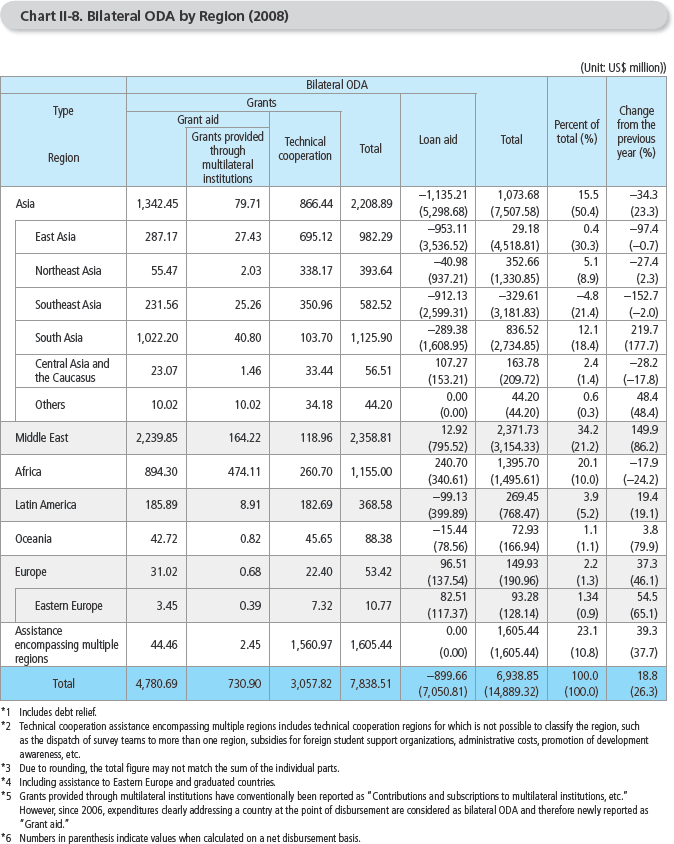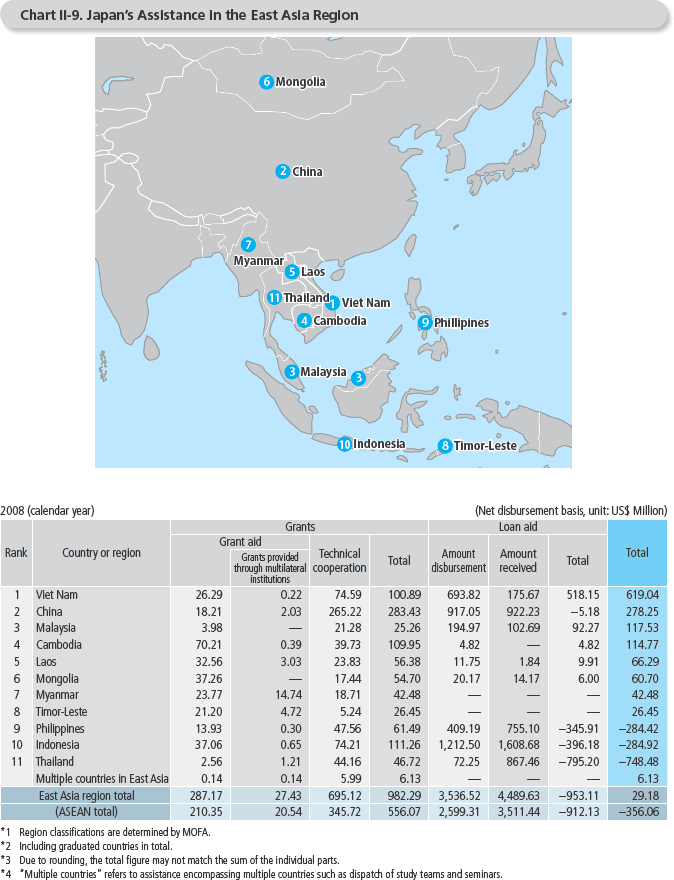Japan's Official Development Assistance White Paper 2009
Section 3 Assistance for Each Region

1. East Asia
•Approximately US$29.18 million (approximately US$4,518.81 million)(Note 38)
•Approximately 0.4% of total bilateral aid (approximately 30.3%)
East Asia consists of a variety of nations. Some, such as the Republic of Korea (ROK) and Singapore, have attained rapid economic growth and have already shifted from aid recipients to donors. On the other hand, there are still some least developed countries (LDCs) within East Asia, such as Cambodia and Laos. There are also countries such as China, which still has internal disparities even though its economy as a whole has grown dramatically in recent years, or Viet Nam, which is in the process of transitioning from a centrally-planned economy to a market economy. These countries have close relationships with Japan in all aspects including political, economical, and cultural, and the development and stability of this region has great significance for the peace and prosperity of Japan.
In November 2009, which was the Mekong-Japan Exchange Year 2009, the first Mekong-Japan Summit Meeting between the Heads of Governments of Japan and the Mekong region countries was held in Tokyo. Prime Minister Hatoyama declared that Japan commits more than ¥500 billion of ODA in the next 3 years for the Mekong region to flourish further more.
• For Japan's efforts in the Mekong region, see also Part I, Chapter 1, Section 1.
In extending assistance, Japan fully takes into account such diversity in socio-economic conditions and changes in the respective assistance needs in East Asian countries.
Notes:
(38) Figures in parentheses are in an aggregate disbursement base.
<Japan's Efforts>
Japan has contributed to the remarkable economic growth in East Asia by combining ODA with trade and investments to provide infrastructure development, assistance for systems and human resource development, promote trade, and vitalize private investments. Currently, Japan aims to further enhance open regional cooperation and integration based on sharing basic values while also ensuring regional stability by promoting mutual understanding. For that reason, Japan has made efforts to respond to transnational problems such as terrorism and piracy, natural disasters, environment and climate change, and infectious diseases, in addition to working for the promotion of mutual understanding through large-scale youth exchanges, cultural exchanges, as well as Japanese language education and Japanese-style education.
In order to position Asia as a center of growth open to the world and to respond to the current financial and economic crisis, it is important to secure economic prosperity for Japan as well as other countries in the region. Japan thus provides assistance to enhance growth potential and to expand domestic demand in Asia. Moreover, in April 2009, Japan released the Growth Initiative towards Doubling the Size of Asia's Economy. Thereupon, Japan announced that it would provide a maximum of two trillion yen in ODA. Through this undertaking, Japan provides assistance in sectors and for people that are easily impacted by the crisis, such as by supplying flexible funds for expanding domestic demand and for developing a safety net, while also providing assistance for developing infrastructure, constructing low-carbon societies, and promoting human resource development and exchanges.
• Support for Southeast-Asia
Since April 2007, Japan has been implementing the Japan-Mekong Region Partnership Program, which rests upon the following three priority areas: (1) Integrate Economies of the Region and Beyond, (2) Expanding Trade and Investment between Japan and the Region, and (3) Pursue Universal Values and Common Goals of the Region. Under this program, Japan has been expanding its assistance to each CLV country (Cambodia, Laos, and Vietnam) as well as to the region as a whole. Japan also contributed nearly US$52 million to the Japan-ASEAN Integration Fund (JAIF) to promote a comprehensive economic partnership between Japan and ASEAN, of which approximately US$20 million would be to assist the "Development Triangle," parts of which is the area consisting of the three CLV nations. Furthermore, at the Japan-Mekong Foreign Ministers' Meeting, held in January 2008 in Tokyo, approximately US$20 million was declared for improving efficiency of logistics in the East-West Economic Corridor.
In November 2009, the First Mekong-Japan Summit Meeting between the Heads of the governments of Japan and the Mekong region countries was held, where they shared the recognition of giving priority to the following areas and of establishing a new partnership for the flourishing common future: 1) Comprehensive Development in the Mekong Region, 2) Environment, Climate Change/ Overcoming Vulnerability, and 3) Expansion of Cooperation and Exchanges and establishing "A New Partnership for the Common Flourishing Future.". Japan continues the policy to expand its Official Development Assistance (ODA) to CLV countries respectively as well as to the Mekong region as a whole. Japan committed more than ¥500 billion of ODA in the next 3 years for the Mekong region to further flourish.
At the same time, economic partnership agreements (EPA) between Japan and Indonesia, Brunei, Philippines, and the ASEAN as a whole went into effect in 2008. An agreement between Japan and Vietnam also entered into force in October 2009.With these EPAs, Japan has been working to expand trade and investments and enhance wide-ranging economic relations that include the harmonization of economic systems such as intellectual property systems and competition policies. Through these efforts, Japan advances the sharing of basic ASEAN values, including democracy, the rule of law, and a market economy, works to reduce poverty, and supports regional integration by rectifying disparity within the ASEAN region.
In August 2008, Japan provided a Climate Change Program Loan to Indonesia in order to support climate change countermeasures in the country. Projects are also underway in Indonesia for supporting the investment environment, energy-related cooperation, disaster countermeasures, maritime safety in the Straits of Malacca and Singapore, as well as improvement of ports security.
Japan reinforces its collaboration with the Asian Development Bank (ADB) which is engaged in a range of regional cooperation in the Asian region. For instance, in order to support efforts made by developing countries in Asia, Japan has established the "Accelerated Co-Financing scheme with ADB (ACFA)," which enhances cooperation between ADB and the Japan Bank for International Cooperation (JBIC)(Note 39), the "Investment Climate Financing Fund (ICFF)," and the "Asian Clean Energy Fund (ACEF)," under the "Enhanced Sustainable Development for Asia (ESDA)," on measures to promote investment and energy efficiency in the region.
Notes:
(39) This activity has been carried on from an overseas economic cooperation operation of the Japan Bank for International Cooperation (JBIC) as part of the loan assistance cooperation of the Japan International Cooperation Agency (New JICA) since October 2008.
• Relations with China
Since 1979, Japan's assistance to China has helped the infrastructure development in coastal areas, environmental measures, improvement in the basic human needs sectors including health and medical care, and human resource development, among other efforts that contribute to the steady development of its economy. As such, Japan's assistance has played a significant role in promoting and sustaining China's reform and opening policy. Most of the assistance in these areas was provided to China in the form of loan aid. The assistance can be valued as having supported the development of economic relations between Japan and China as well as having functioned as one of the main pillars for the multilayered Japan-China relationship. Regarding this point, the representatives of China, including at the summit-level, have expressed their gratitude on many occasions. In light of China's recent remarkable economic growth, Japan and China recognized that ODA loans for the country from Japan will come to a harmonious end by the 2008 Beijing Olympics. Therefore, new provision of loan aid was halted with the six Exchanges of Notes in December 2007.
Yet, the people of Japan and China face many common challenges to tackle, including global issues such as environmental issues and infectious diseases that affect Japan directly. During President Hu Jintao's official visit to Japan in May 2008, in a Joint Statement between the Government of Japan and the Government of the People's Republic of China regarding the Comprehensive Promotion of a Mutually Beneficial Relationship Based on Common Strategic Interests, the leaders of both countries confirmed that cooperation will be undertaken mainly in the areas of energy and the environment, while a joint declaration was issued relating to climate change. Moreover, increasing the mutual understanding between the people of Japan and China is an important issue from the perspective of facilitating the sound development of Japan-China relations. In light of this situation, grant aid is currently being implemented with its focus narrowed on: (1) areas conducive to resolving common challenges faced by the people of Japan and China such as the environment and infectious diseases, and (2) areas conducive to promoting mutual understanding and increasing exchanges between Japan and China. Also, in terms of technical cooperation, Japan is particularly focusing on projects aiming for the transition to a market economy, observance of international rules, promotion of good governance, and energy conservation. Exchanges of people can serve as an important means for transmitting Japanese values and culture to China. Based on the conditions surrounding bilateral relations, the cooperation will be conducted with appropriate deliberation from a comprehensive and strategic viewpoint.

Jakarta Mass Rapid Transit System Project (Indonesia)
Supported by robust domestic consumption and private investments, in the first half of 2008 Indonesia enjoyed an economic growth rate of over 6.3%. However, this growth is slowing down due to the impact of the financial and economic crisis that took place in the latter half of 2008. Therefore, it has become important challenges to maintain sustainable development and create employment opportunities are becoming important issues to be handled by implementing secure fiscal policies and developing economic infrastructure for improving the investment environment. Japan assists the construction of a mass rapid transit system through an approximately ¥48.1 billion ODA loan in order to ameliorate the escalating traffic congestion in the Jakarta metropolitan area. Once the railway is completed, the time necessary to travel from central to southern Jakarta is expected to reduce from the current two-hour trip to about 30 minutes. These efforts are anticipated to boost passenger transportation capacity and improve the investment environment.
